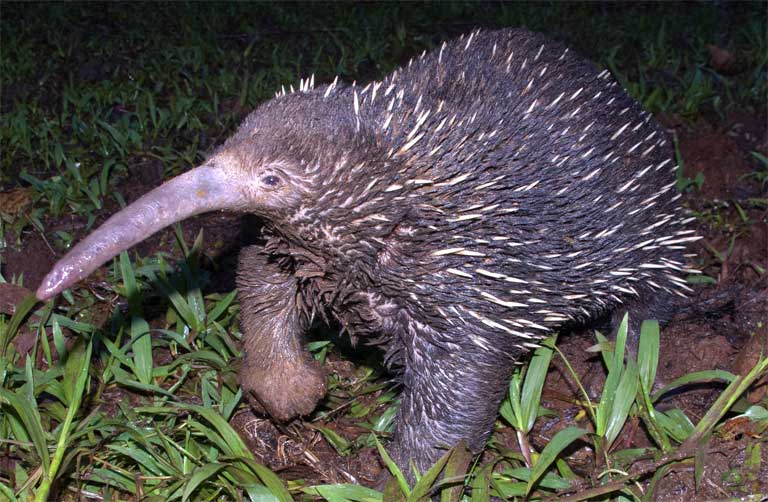Welcome to the Spiky Realm of Echidnas!
Hello, nature-enamored parents! Are you ready to unravel the secrets of one of nature’s most enigmatic creatures – the echidna? Often referred to as spiny anteaters, these little mammals are a peculiar marvel of the animal kingdom. Grab a comfy seat and prepare for an engaging journey into the life of the echidnas that will not only satisfy your curiosity but also provide a treasure trove of information for your little ones to discover!
What is an Echidna, Anyway?
If you’re picturing something soft and cuddly, think again! Echidnas (pronounced ih-KID-nuh) are extraordinary, egg-laying mammals known for their sharp spines and peculiar snouts. Belonging to a small group called monotremes, which they happen to share with the platypus, these creatures are one of Earth’s evolutionary marvels – a perfect topic to captivate your children’s imagination and ignite their interest in the natural world.
The Fascinating Family of Monotremes
Monotremes are a tiny, exclusive club in the mammalian world. What sets them apart is their unique reproductive process which involves laying eggs instead of giving birth to live young, a topic that can spark curious questions and educational discussions at home. Dive into biology with your kids by exploring the peculiarities of monotremes!
Discovering the Echidna’s Natural Habitat
With their strong limbs built for digging, echidnas are the architects of the ground beneath our feet. They mainly inhabit Australia and New Guinea where they thrive in a variety of environments. Whether it’s the arid outback or dense forests, echidnas are masters at making themselves at home.
Echidnas and Their Love for Solitude
Unlike many other mammals, echidnas are pretty much loners. These solitary creatures typically come together only to breed. They communicate through an array of sounds and smells, which can be a fun point of discussion for you and your kids—why do animals need to communicate, and how do they do it?
The Echidna’s Unusual Diet
Ready to gross out (or perhaps intrigue) your young ones? Echidnas love to feast on ants, termites, and worms. Using their long, sticky tongues, they slurp up their prey like living spaghetti strands! This dietary habit plays an important role in the ecosystem by controlling insect populations and enriching the soil.
Echidna Superpowers: Digging and Hibernating
Discuss superpowers with your children and watch their eyes widen with amazement as they learn about the echidna’s impressive abilities. From digging through solid earth to hibernating during extreme weather, your family can discover how these skills help the echidna survive in its habitat.
Understanding Echidna Behavior and Interaction
Now, let’s get into the social lives of these spiky creatures. Did you know that echidnas have a special mating ritual known as the “love train”? It’s a peculiar sight and one that can definitely instill awe and giggles in equal measure! This unique behavior can lead to discussions about biology, animal behavior, and the wonders of the natural world.
The echidna is a creature that’s not just fascinating, but also serves as a perfect subject to connect children with science and nature. Stay tuned for more insights as we deep-dive into the echidna’s development, conservation status, and why they’re an important part of our world’s biodiversity. We will unveil all these intriguing details while nurturing a love for learning in your children. So, pull out those explorer hats and get ready for more spiky adventures!

The Lifecycle and Remarkable Resilience of Echidnas
When you think of ancient creatures, dinosaurs might be the first to come to mind. However, echidnas too are descendants of a lineage that dates back to a time when giant reptiles roamed the earth. Their survival is a testament to their adaptability and resilience – an excellent lesson for kids about the importance of adapting to changing environments.
Here’s a fascinating glimpse into the lifecycle of an echidna that can double as a biology lesson for your curious little ones:
- Egg-laying: A female echidna lays a single leathery egg and tucks it into her pouch—yes, much like a kangaroo!
- Hatching: After about 10 days, the egg hatches, revealing a tiny, spineless puggle. These babies are not only adorable, but they’re also an awesome way to introduce your kids to early development in mammals.
- Growing Up: For the first few months, the puggle stays within the safety of mom’s pouch, nourishing itself with milk and growing its iconic spines.
- Venturing Out: Eventually, the young echidna will leave the safety of the pouch and start exploring the world, perfecting its digging and foraging skills.
- Survival Skills: Echidnas do not reach maturity until they are about five years old, learning throughout this period how to thrive independently in harsh environments.
Five Vital Echidna Facts for Parents to Share
There’s more to echidnas than just their distinctive looks and habits. Here are five things parents should know when preparing to introduce their children to the fascinating world of the echidna mammal:
- Conservation Status: Most echidna species are considered stable, but certain populations face threats from habitat loss and invasive predators. Discussing conservation with your kids is a great way to instill values of environmental stewardship.
- Sensory Prowess: Echidnas have incredible hearing and a keen sense of smell, which they use to navigate their environments and find food. This sensory acuity can be a fascinating discussion point about the various ways animals interact with their world.
- Thermoregulation: These creatures can regulate their body temperature to survive extreme temperatures – a superpower that bewilders even scientists!
- Educational Opportunities: Echidnas make for excellent educational subjects, offering a myriad of lessons on evolution, adaptation, and the environment.
- Low Public Visibility: Echidnas are primarily nocturnal and elusive, making them less visible to the public eye. Still, there are rare opportunities for safe and respectful wildlife encounters that can be memorable family outings.
Echidnas and Biodiversity: Why They Matter
Echidna’s ecological role extends well beyond insect control. These spikey creatures contribute significantly to soil health by aerating it as they dig for food. Teaching your kids about the importance of echidnas in our ecosystem can create early awareness and appreciation for the interconnectedness of life on Earth.
Whether studying their primitive reproductive methods, distinctive foraging techniques, or learning about their contribution to their habitats, echidnas are a gateway to a wider understanding of biodiversity and the delicate balance of our natural world.
By sharing knowledge about echidnas with your children, you’re not just nurturing their intellectual curiosity; you’re also laying the groundwork for a lifelong love and respect for wildlife. And who knows? This guide might just inspire the next generation of biologists, ecologists, or simply informed citizens who care deeply about our planet’s many wonders. So let’s celebrate and cherish these remarkable creatures – the spiky, yet utterly endearing echidnas!




